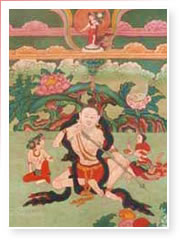
The Great Yogi Saraha
The Great Yogi Saraha.
Acclaimed one of the greatest yogis of India in the late 8th century, the indomitable Saraha heads the Mahamudra lineage. He was born into a brahmin class family in Bengal, eastern India, and was raised to become a Buddhist monk. The Pala dynasty of Bengal promoted Buddhism, supported many large Buddhist universities, and encouraged wide-spread learning. Saraha become one of the noted sages of his time. He did not, however, remain a monk.
One story has it that he was expelled from the monastic order for indulging in alcohol or some similar breakage of the rule. This may be, or he may have left of his own accord. At any rate, he became a wandering, white robed yogi, homeless and free of desire, seeking only to fathom the mystery of life.
He became the disciple of a saint named Ratnamati, who was a master of the Guhyasamaj Tantra. Thus Saraha learnt the profound secrets of a method of meditation that focuses on raising kundalini (Tib: gTum-mo) and abiding in blissful Mind’s own innate state.
As a yogi, traveling aimlessly from place to place across the glorious land of India, eventually Saraha met a young women with similar aspirations to his own. The two became husband and wife. Settling in isolated places, residing in cemetery grounds and in lonely Himalayan temples, they committed themselves to spiritual endeavour.
Saraha’s bride was from a low caste clan of arrowsmiths. Since Saraha, no longer a single monk, now required an occupation to support his wife and family, he took up the trade of making arrows. The very name “Saraha” derives from his occupation as a maker of arrows. When not making and selling arrows, the couple spent their time in Mahamudra meditation, cutting the linear flow of thought, so as to experience naked consciousness in all its unveiled brilliance. Thus the two of them eventually attained mutual Enlightenment together!
Challenged by the people, and having the reputation of a monk fallen from the spiritual Path, Saraha was brought before the king of the land. To declare his innocence and his realization, he then recited before the whole court, a series of spontaneous yogi songs, known as The Three Cycles of Doha. He addressed the first song to the King, the second set to the Queen, and the third set he sang to the assembled people. These songs became famous throughout Bengal and everyone was satisfied that Saraha was a true yogi.
Other short songs have circulated, said to be the composition of Saraha. One speaks directly of the “straight way”, making allusion to the straightness of the arrows crafted by the smith. The straight arrow is itself a mystical play on the force of kundalini rising up the central nervous channel, where psyche merges with the Divine at the crown of the head, resulting in oceanic samadhi, endless bliss and effortless wisdom. Saraha sang:
Neither vibration (nada) nor point (bindu),
neither sun nor moon — the sovereign Mind
is in and of itself ever liberated.
Abandon not the straight route,
to meander down the crooked way.
Enlightenment is near,
so don’t dally in worldly life.
The bangle on your wrist, do not attempt
to see it looking in a mirror:
look to yourself – see Innate Mind direct!
Those going on either bank
are fools pursuing the way of death.
Of the channels cut on left and right,
Saraha says: O! mistake these not
for the route that is straight!
Saraha composed a main meditation text which has been transmitted and studied in the Ka’gyu Order, now for many centuries. This is one of the fundamental treatises of the Mahamudra meditation tradition.
Saraha begins the lineage which descends through his disciple Savari to Luipada, to Dengri, Vajraghanta, Kambala, Jalandhara, Krsnacarya, Vijayapada, to Tilopa and Naropa, the teachers of Marpa of Lhotrak. Marpa was the renowned teacher of Tibet’s greatest yogi Milarepa, and the latter taught Gampopa, to in turn was the teacher of the first Karmapa. Today, the Karmapa is the living custodian of this Mahamudra meditation lineage.
An alternate lineage through Saraha’s other disciple, Nagarjunapada, runs in succession through Savari to Maitripada to Marpa, Milarepa, Gampopa, and likewise to the Karmapa.
https://www.dharmafellowship.org/biographies/historicalsaints/saraha.htm, see also https://www.enlightened-spirituality.org/Saraha.html, https://en.wikipedia.org/wiki/Saraha, https://books.google.com.au/books?id=c1yIgFTF_FoC&printsec=frontcover&dq=Tantric+Treasures:+Three+Collections+of+Mystical+Verse+from+Buddhist+India&source=bl&ots=cIVabr6cp_&sig=JG9BDaNreNhrp6cOzCsr2YBwp2k&hl=en&ei=iFSSS_WsD5WXkQXo98DvDA&sa=X&oi=book_result&ct=result&resnum=1&ved=0CAgQ6AEwAA#v=onepage&q&f=false, https://books.google.com.au/books?id=U7GqhR2O2acC&printsec=frontcover&source=gbs_v2_summary_r&cad=0#v=onepage&q&f=false